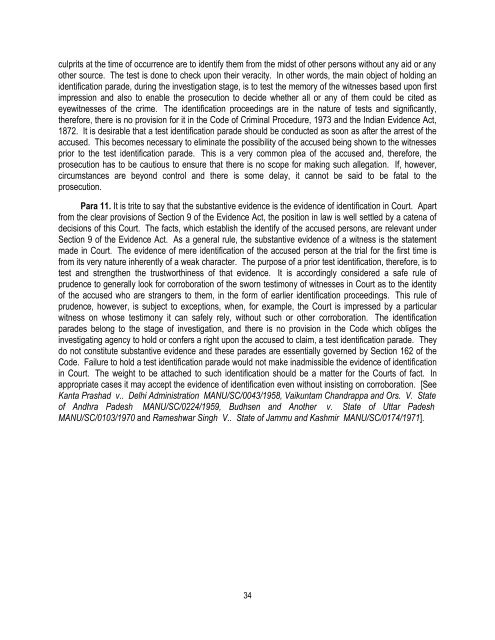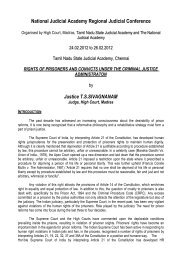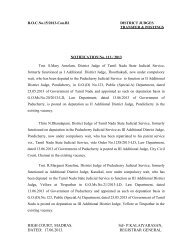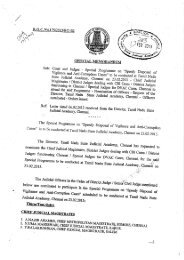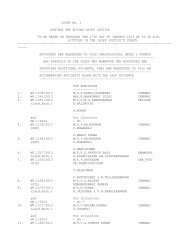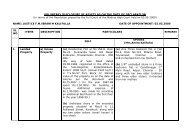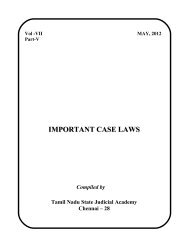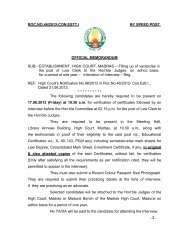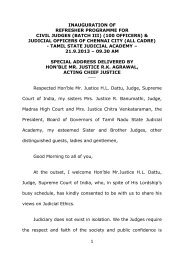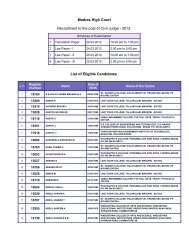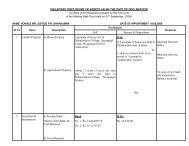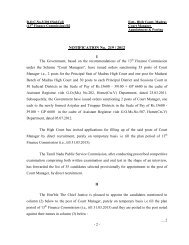Appreciation of Evidence in Sessions Cases - Justice D.Murugesan
Appreciation of Evidence in Sessions Cases - Justice D.Murugesan
Appreciation of Evidence in Sessions Cases - Justice D.Murugesan
You also want an ePaper? Increase the reach of your titles
YUMPU automatically turns print PDFs into web optimized ePapers that Google loves.
culprits at the time <strong>of</strong> occurrence are to identify them from the midst <strong>of</strong> other persons without any aid or any<br />
other source. The test is done to check upon their veracity. In other words, the ma<strong>in</strong> object <strong>of</strong> hold<strong>in</strong>g an<br />
identification parade, dur<strong>in</strong>g the <strong>in</strong>vestigation stage, is to test the memory <strong>of</strong> the witnesses based upon first<br />
impression and also to enable the prosecution to decide whether all or any <strong>of</strong> them could be cited as<br />
eyewitnesses <strong>of</strong> the crime. The identification proceed<strong>in</strong>gs are <strong>in</strong> the nature <strong>of</strong> tests and significantly,<br />
therefore, there is no provision for it <strong>in</strong> the Code <strong>of</strong> Crim<strong>in</strong>al Procedure, 1973 and the Indian <strong>Evidence</strong> Act,<br />
1872. It is desirable that a test identification parade should be conducted as soon as after the arrest <strong>of</strong> the<br />
accused. This becomes necessary to elim<strong>in</strong>ate the possibility <strong>of</strong> the accused be<strong>in</strong>g shown to the witnesses<br />
prior to the test identification parade. This is a very common plea <strong>of</strong> the accused and, therefore, the<br />
prosecution has to be cautious to ensure that there is no scope for mak<strong>in</strong>g such allegation. If, however,<br />
circumstances are beyond control and there is some delay, it cannot be said to be fatal to the<br />
prosecution.<br />
Para 11. It is trite to say that the substantive evidence is the evidence <strong>of</strong> identification <strong>in</strong> Court. Apart<br />
from the clear provisions <strong>of</strong> Section 9 <strong>of</strong> the <strong>Evidence</strong> Act, the position <strong>in</strong> law is well settled by a catena <strong>of</strong><br />
decisions <strong>of</strong> this Court. The facts, which establish the identify <strong>of</strong> the accused persons, are relevant under<br />
Section 9 <strong>of</strong> the <strong>Evidence</strong> Act. As a general rule, the substantive evidence <strong>of</strong> a witness is the statement<br />
made <strong>in</strong> Court. The evidence <strong>of</strong> mere identification <strong>of</strong> the accused person at the trial for the first time is<br />
from its very nature <strong>in</strong>herently <strong>of</strong> a weak character. The purpose <strong>of</strong> a prior test identification, therefore, is to<br />
test and strengthen the trustworth<strong>in</strong>ess <strong>of</strong> that evidence. It is accord<strong>in</strong>gly considered a safe rule <strong>of</strong><br />
prudence to generally look for corroboration <strong>of</strong> the sworn testimony <strong>of</strong> witnesses <strong>in</strong> Court as to the identity<br />
<strong>of</strong> the accused who are strangers to them, <strong>in</strong> the form <strong>of</strong> earlier identification proceed<strong>in</strong>gs. This rule <strong>of</strong><br />
prudence, however, is subject to exceptions, when, for example, the Court is impressed by a particular<br />
witness on whose testimony it can safely rely, without such or other corroboration. The identification<br />
parades belong to the stage <strong>of</strong> <strong>in</strong>vestigation, and there is no provision <strong>in</strong> the Code which obliges the<br />
<strong>in</strong>vestigat<strong>in</strong>g agency to hold or confers a right upon the accused to claim, a test identification parade. They<br />
do not constitute substantive evidence and these parades are essentially governed by Section 162 <strong>of</strong> the<br />
Code. Failure to hold a test identification parade would not make <strong>in</strong>admissible the evidence <strong>of</strong> identification<br />
<strong>in</strong> Court. The weight to be attached to such identification should be a matter for the Courts <strong>of</strong> fact. In<br />
appropriate cases it may accept the evidence <strong>of</strong> identification even without <strong>in</strong>sist<strong>in</strong>g on corroboration. [See<br />
Kanta Prashad v.. Delhi Adm<strong>in</strong>istration MANU/SC/0043/1958, Vaikuntam Chandrappa and Ors. V. State<br />
<strong>of</strong> Andhra Padesh MANU/SC/0224/1959, Budhsen and Another v. State <strong>of</strong> Uttar Padesh<br />
MANU/SC/0103/1970 and Rameshwar S<strong>in</strong>gh V.. State <strong>of</strong> Jammu and Kashmir MANU/SC/0174/1971].<br />
34


